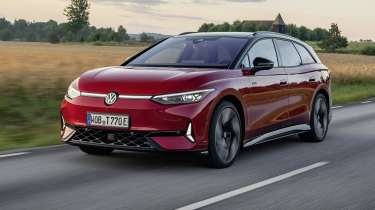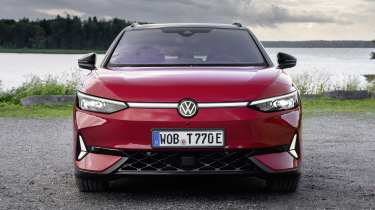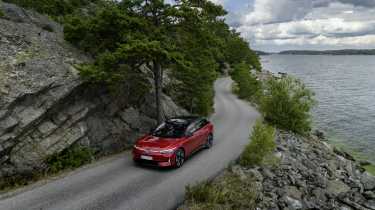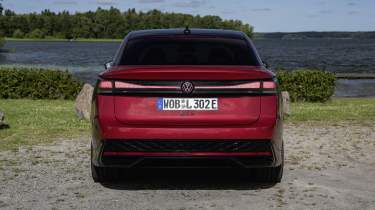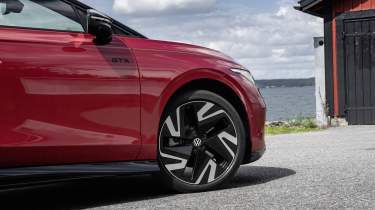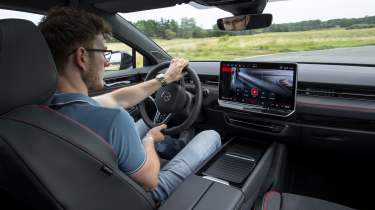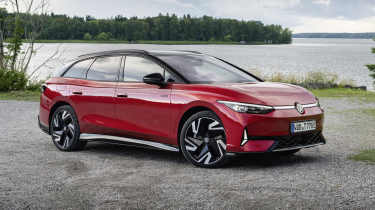Volkswagen ID.7 GTX 2024 review – Wolfsburg’s most powerful estate targets the BMW i5
The largest EV in Volkswagen’s ID range receives the GTX treatment, and while it’s hardly a driver’s car, it’s our pick of the lineup
Volkswagen’s all-electric ID range didn’t get off to the strongest of starts with the half-baked ID.3, but in the years since, a swathe of new models have increased the badge’s appeal. The latest to join the ranks is the ID.7, the largest EV in the lineup, and while the standard car focuses on range and practicality, the latest GTX variant aims to bring more driver engagement to the table.
While the GTX nameplate is considered to be Volkswagen’s electric equivalent to GTI, its specs indicate it’s still no match for some of its more premium German rivals. We get behind the wheel for the first time on the narrow, undulating country roads of Sweden to find out where it stands in this fledgling segment.
> Volkswagen ID.7 review – Wolfsburg’s answer to the BMW i5
Powertrain and technical highlights
Unlike the ordinary ID.7 Pro and Pro S models which are single-motor, rear-drive only, the GTX has been given an additional motor at the front to help lift its performance credentials. The result is a 335bhp combined output, putting it 53bhp ahead of the standard ID.7 and coincidentally (or not), giving it the exact same power as the rear-drive BMW i5 eDrive40; this output figure also makes it the most powerful production saloon and estate car Volkswagen has ever produced.
More reviews
In-depth reviews
On the rear axle, the GTX utilises the same in-house developed APP550 rear motor as the ordinary Pro and Pro S ID.7 models, producing 210kW (282bhp) and 402lb ft of torque alone. With output from the GTX-specific front motor standing at 80kW (107bhp), it has plenty of punch, even if combined output only just matches the entry-level BMW i5. Operating much like the Haldex system on Volkswagen Group’s all-wheel-drive performance cars, the front motor is only called into action when additional traction is required for efficiency purposes.
Performance and 0-62 time
Performance-badged EVs typically jump leagues ahead of their combustion-powered equivalents with far superior 0-62mph times, but the ID.7 GTX’s figures are modest. Standstill to 62mph happens in a claimed 5.4sec for the saloon and 5.5sec for the estate, with top speed limited to just 112mph for both.
While 0-62mph comes six tenths ahead of the 6sec claim of the i5 eDrive40 (likely due to its single-motor, rear-drive configuration), the BMW hits a higher 120mph top speed. Should you have anything to tow with your ID.7, you’ll be pleased to hear that this additional motor has not only boosted acceleration, but also maximum towing capacity, jumping from 1200 to 1400kg.
> Volkswagen Golf GTI Clubsport S (2016, Mk7): an ultra-exclusive hot hatch great
In reality, its extra power and traction makes much more of a difference to performance than the specs would suggest, with significantly more urgency on the move and from a standstill (even in comfort mode) – it finally has the bite you expect from a more premium EV, something the standard car swaps for outright efficiency.
Ride and handling
Ensuring a 2365kg EV tackles a twisty B-road in a pleasant manner is never going to be an easy task, but Volkswagen’s engineers have done a good job. With GTX-specific chassis tuning, software, steering and uprated stabilisers, the ID.7 is now much more enjoyable to drive than the standard car. The steering response, body control and overall response are all improved.
What it isn’t is an electric GTI. These tweaks bring the ID.7 in-line with its more premium German rivals in terms of driver feedback and dynamic ability, but driving the ID.7 GTX for pure enjoyment is not something we can imagine ourselves doing.
While the standard ID.7 in Pro and Pro S-form is soft-edged in almost every aspect, the GTX tightens things up, adding well-judged steering heft and response, improving body control while bringing the option of an ESC Sport Mode and Dynamic Chassis Control to the table.
Stepping straight from a Pro S to the GTX, the ride is noticeably firmer even in Comfort mode, but not to its detriment – our test car was equipped with the larger 21-inch wheels and even this didn’t spoil the ride on our particular route. These new suspension rates give the GTX much-needed body control given its weight, and help contribute to its improved steering response too.
Up the pace and its 235 front, 255 rear (or 265 on the 21-inch wheels) tyres make its weight impossible to ignore, but the new all-wheel drive controller helps distribute power to where it’s needed most. The electronic differential locks also help improve traction and provide some element of predictability out of corners.
One area without any noticeable performance improvement are the brakes, which have the same vague, long pedal as the standard car. Blending friction brakes with regenerative braking is never an easy job, and while the transition is thankfully smooth in this application, they’re not particularly confidence-inspiring. Regenerative braking is not quite as strong as in some EVs either which won’t be for some, as it makes one-pedal driving difficult even in B-mode.
MPG and running costs
The ID.7 offers impressive range in all of its forms. Thanks to a slippery 0.23 drag coefficient and the same huge 91kWh battery pack (86kWh useable) as in the ID.7 Pro S, even the performance-oriented GTX achieves a WLTP-certified 370 miles (363 miles for the estate) of range; that’s 71 miles shy of the single-motor Pro S and 14 miles ahead of the BMW i5 eDrive40. The Tesla Model S achieves up to 394 miles WLTP in its most efficient form, but isn’t available to purchase in the UK at the time of writing.
Charge can now be accepted at up to 200kw on a DC fast charger (a 25kw improvement over earlier ID.7s) allowing for a 10 - 80 per cent fill in just 26 minutes under ideal conditions. Given the huge battery size though, home charging could take quite some time depending on the charging rate of your setup, which is worth keeping in mind.
While numerous measures have been taken in order to achieve the ID.7’s impressive efficiency (Volkswagen quotes a best-case 3.4mi/kWh, 0.4kWh down on the BMW i5), buyers of even the GTX range-topper will have to fork out £1050 to have a heat pump fitted, something that comes as standard on a sub-£40,000 Tesla Model 3. This would improve efficiency further, especially in colder climates, something that would be very handy to have in the UK.
Interior and tech
The cabin hasn’t seen much change, but it’s a pleasant place to be regardless. The heated, cooled and massaging front seats now come with sleek perforated GTX letting, red piping and contrast stitching in the fabric and microfibre upholstery. The steering wheel is the same unit you’ll find in standard cars, but GTX-specific lettering, stitching and red elements make sure you never forget which variant you’re driving.
Launched as part of the latest ID.7 update, the GTX comes with a raft of updates to its infotainment software in-line with the rest of the range. The ID.7’s standard augmented-reality head-up display, for example, can now display navigation directions from Apple CarPlay or Android Auto, something it could only do from the in-built navigation system before. There’s also now functionality for ‘AirConsole’, an in-car gaming system that will be making its way to models from multiple manufacturers in the coming months. Our brief test confirms that while perhaps a gimmick for those without children, it’s a good way to pass time during charging sessions should you be without anything productive to do…
Those frustrating touch-controlled touch sliders and steering wheel buttons have been carried across from the rest of Volkswagen’s range, but there are numerous elements that make the ID.7 feel more premium than models beneath it. Well-integrated, 30-colour ambient lighting, an optional panoramic sunroof with electrochromic glass and a 12-speaker, 700w Harman Kardon sound system all help it reach closer to its more premium German rivals. There’s no doubt that the equivalent BMW i5 feels more solid, premium and intuitive to use, but then it does command a higher price.
Design
The Volkswagen ID.7 looks like a car designed for efficiency, with its blunt nose and tapered rear end. It also looks huge, as while its dimensions are near-identical to the BMW i5 (which itself is hardly a small car), its design makes it appear much taller than a conventional saloon/estate – follow one from a distance and it can be hard to distinguish it from an SUV.
The GTX adopts the same basic design as any other ID.7 but Volkswagen has added new front and rear bumpers for an added touch of aggression, along with a new honeycomb grille. There are also more gloss black trim elements than on the standard car, with a black roof, darkened windows and GTX-exclusive 20-inch Skagen wheels also part of the package – 21-inch wheels are a £620 option.
Being the range-topper, the GTX gets illuminated badges and IQ.Light LED matrix headlights as standard with GTX-specific daytime running lights, connected via a full-width lightbar in a similar fashion to the Mk8 Golf. There’s a full-width lightbar at the rear, too, which displays a neat welcome and goodbye animation should you care about that sort of thing – these lights are also customisable from within the cabin, with a few presets to choose from.
Price, specs and rivals
The ID.7 GTX is a direct rival to the BMW i5, but with its most basic eDrive40 variant coming at a £5715 premium to the Volkswagen, Wolfsburg’s offering is a significantly more attractive option for those on a budget – the range-topping i5 M60 might seem the most logical rival to a GTX-badged ID.7, but at £97,745 and with almost 600bhp, there’s no comparison.
The Tesla Model S would be another rival, but with this model off sale in the UK at the time of writing (with no sign of it returning soon), there aren’t many places to turn should you be looking for a long-range, all-electric saloon. The Model 3 is available in the UK and offers much more impressive stats in Performance trim for less money, but it falls into the class below the ID.7.
Opt for the ID.7 GTX Touring and you’ll only pay an additional £690, lifting the basic price to £62,670; that’s £7275 less than the cheapest BMW i5 Touring, which comes in at £69,945. First deliveries for both variants are expected to commence towards the end of 2024.
Volkswagen ID.7 GTX specs
| Powertrain | Dual-motor, all-wheel drive |
| Power | 335bhp |
| Torque | TBC |
| 0-62mph | 5.4sec (5.5 for the Touring) |
| Top speed | 112mph |
| Weight | 2365kg |
| Power-to-weight | 142bhp/ton |
| Range (miles, WLTP) | 370 (363 for the Touring) |
| Price | £61,980 (£62,670 for the Touring) |
